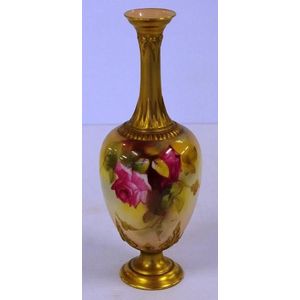Doulton Burslem Pedestal Vase by Alice Hall
You must be a subscriber, and be logged in to view price and dealer details.
Subscribe Now to view actual auction price for this item
When you subscribe, you have the option of setting the currency in which to display prices to $Au, $US, $NZ or Stg.
- Earthenware - A basic ceramic material that is fired at a low temperature. Earthenware is the basis of almost all ancient, medieval, Middle Eastern and European painted ceramics. After firing, the colour is the colour of the clay when it is dug from the ground: buff, brown and red. It is not waterproof until glazed. Creamware is a type of earthenware covered with a transparent lead glaze. Majolica, faience and delft are also earthenware covered in an opaque white tin glaze.
- Filigree Work - Decorative Arts - Delicate decorations using fine threads of ceramics, glass or other materials to give a lace-like effect, attached together and applied as an ornament.
- Circa - A Latin term meaning 'about', often used in the antique trade to give an approximate date for the piece, usually considered to be five years on either side of the circa year. Thus, circa 1900 means the piece was made about 1900, probably between 1895 and 1905. The expression is sometimes abbreviated to c.1900.
This item has been included into following indexes:
- Royal Doulton (England) Series Ware - Floral 279
-
Royal Doulton (England), item types
- Burslem 401
- ovoid and baluster shaped vases 1,556
Visually similar items

A Royal Worcester Persian style blush ivory vase, 1907, an elegant ovoid vase with a slender trumpet neck and a pedestal base, having a moulded collar with pendant motifs, and a lappet border to the lower section, decorated to the body with loose sprays of

A Doulton Lambeth vase, circa 1920s, numbered 8723, the salt glazed vase of slender ovoid form with a trumpet neck and pedestal base, decorated with applied neoclassical borders with anthemion motifs, scrolls and lappets in sage and blue colours upon a ric

Royal Worcester handpainted 'Rose and Gilt' vase. Height 19 cm approx.

A Victorian Royal Worcester gilded vase. 1900, the vase of globular form in ivory tones with tea stain colours, a moulded cup form rim, and a decorative lappet and patterned collar, small chilong style handles, decorated to the body with gold paste tendril
